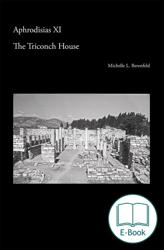The Triconch House at Aphrodisias is one of the best preserved late antique houses in the Roman world. It represents only one phase, however, in a much longer continuum of occupation of its site, which was located at the heart of the monumental center of the Greco-Roman city. This book presents a detailed account of the late antique building as well as the history and development of its urban location, roughly the size of a city block, over the course of more than 1000 years, from around the first century BC through the twelfth century AD.
The Triconch House is a large, late antique peristyle house in Aphrodisias in southwestern Asia Minor. Previously known as the Bishop’s Palace, it is one of the best preserved late antique houses in the Greek East and one of several in the Roman empire with a triple-apsed, or triconch, dining room. Its decorative program included large-scale figural wall paintings, a display of sculpture, and polychrome mosaic floors. The late antique house represents, however, only one phase in a much longer continuum of occupation of its site, which was roughly the size of a city block and located at the heart of the monumental urban center. This study is concerned both with the history and development of the urban location of the Triconch House and with the details of the late antique building. It traces the development of a plot of land measuring roughly 50m by 50 m over the course of some 1200 years, from at least the first century BC through the twelfth century AD. This study examines the house within its immediate surroundings in the northern part of the city center and considers these within the larger context of the urban development of Aphrodisias. At every stage of its history, the site of the Triconch House was intimately linked with the structures and institutions that surrounded it, and its evolution follows the major phases of the history of Aphrodisias. Structures were first built there during the city’s emergence as a planned town in the late Hellenistic period and they continued to be used throughout the imperial period. In late antiquity, when the city was a provincial capital, those structures were transformed into a large and well-appointed townhouse in the center of town. Finally, beginning sometime after the mid-seventh century AD, the Triconch House became a bishop’s residence and remained a component of a larger ecclesiastical complex through the middle Byzantine period, when Aphrodisias was a metropolitan see and pilgrimage site. This study will be of interest to archaeologists and other scholars interested in domestic architecture and urbanism in the Roman provinces, especially in late antiquity and the post-antique/Byzantine phases of Greco-Roman cities. It may also appeal to archaeologists using legacy data and Bauforschung/building archaeology approaches to ancient structures.
Michelle L. Berenfeld
Education
2002 Ph.D., Classical Archaeology and Art, Institute of Fine Arts, New York University
Minor Fields: Hellenistic and Republican/early Imperial Roman History; Medieval Art.
Dissertation: The Bishop’s Palace at Aphrodisias: A Late Roman Townhouse
in the Center of the City. Advisor, Christopher Ratté.
1997 M.A., Art History, Institute of Fine Arts, New York University
1994 B.A., Art History and Politics, New York University
Current Position
John A. McCarthy Associate Professor of Classics, Pitzer College, Claremont, CA, 2016-Present.
The series is dedicated to the publication of archaeological research at the ancient site of Aphrodisias. Aphrodisias was a prosperous city of the Roman period, well known for its cult of Aphrodite and its marble-carvers, and it has remarkably preserved remains from the second century BC to the sixth century AD. The archaeology of the city is especially well-suited to the study of public art and monuments in their ancient contexts and to the investigation of the elaborate architectural mise-en-scène of urban political life in the Eastern Roman empire.


 Vorwort
Vorwort